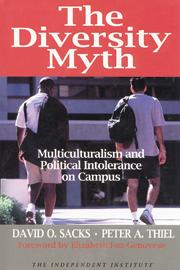In the coming months high school students across the country will wait eagerly for acceptance letters from their college of choice. But because of sky-rocketing tuition costs, many parents will wait with a sense of dread. For the first time, the price of an undergraduate degree at many of our nation’s finest universities exceeds $100,000, a financial hardship that is causing many families to ruminate about whether a “prestige” school is really worth the expense.
A case in point is top-ranked Stanford University, where tuition, room and board will run about $25,749 this year—about the cost of a new BMW 325i. The money largely funds what university President Gerhard Casper has called a “mini-welfare state”–an ever–expanding range of student services and new programs centered around Stanford’s multicultural “experiment.”
To administer its experiment, Stanford employs nearly 7,000 staff members—more than one bureaucrat for every undergraduate—including such inventions as a $50,000 per-year “Multicultural Educator.” (By contrast, there are only 1,400 faculty members.) And there is a large assortment of pricey new multicultural departments (Feminist Studies, Chicano Studies), ethnic centers, residential programs and new classes and conferences. In 1991, the Office for Multicultural Development was established as a cabinet-level department to oversee Stanford’s “transformation.”
In 1994, in a related effort to expand its library collections Stanford paid 1960s poet-activist Allen Ginsberg more than $1million for his personal archives. The collection includes the “beatnik” writer’s manuscripts, journals, dried plant vines from South America, beard clippings and an old pair of tennis shoes. This new-age boondoggle constitutes just one piece of evidence that the growing cost of undergraduate education does not always increase its quality—and may well be undermining it. Consider, in this vein, some of the courses that have been filling Stanford departments in the name of “diversity”:
A core class, “Cultures, Ideas and Values,” required students to compare the Bill of Rights with Lee Iacocca’s “Car Buyer Bill of Rights.” And one student fulfilled a class assignment by attending a Grateful Dead concert.
One new multicultural history seminar, entitled “Black Hair as Culture and History,” addressed how the hair of blacks “has interacted with the black presence in this country, and how it has played a role in the evolution of black society.” Lectures included “The Rise of the Afro” and “Fade-O-Rama, Braiding and Dreadlocks,” and local hair stylists were brought in for a week of discussions.
History 267, “The History of Rights in the United States,” was so busy extolling 1960s protest (“rights”) movements that the class never studied the Declaration of Independence or the Constitution.
Religious Studies 8, “Religions in America,” a class that can be counted toward three different graduation requirements, devoted whole lectures to Shamanism, the Peyote Cult, and the Kodiak sect, but not one to the Catholic Church. When discussed at all, Christianity was viewed from a feminist or gay “perspective.”
Assignments in Feminist Studies 101 have included writing (but not necessarily sending) “a letter to our parents coming out as a lesbian.”
Parents are also advised to check out a school’s graduation requirements—it usually gives away its priorities. While there is no requirement in American history at Stanford, for instance, students are now required to take courses in feminist studies, race theory and Third World culture.
Where is Ralph Nader when you really need him?








